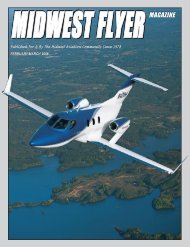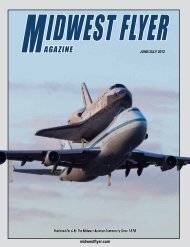You also want an ePaper? Increase the reach of your titles
YUMPU automatically turns print PDFs into web optimized ePapers that Google loves.
and in some cases, this is the only wayto duplicate the problem situation. Abit of advice I will give to every pilot…“Do not take off in a strange airplaneor one that has just come out ofmaintenance to fly in a demanding IFRsituation.”When I get into an airplane I havenot flown before, I need to see how allof the avionics work together. In theearly days of GPS, each FAA FlightStandards District Office (FSDO) setthe standards of installation in theirjurisdiction.All GPS units installed byWisconsin avionics shops that sharedthe CDI needle with the VOR/ILSindicator needed to auto-switch toILS whenever the VOR/ILS radiohad an ILS frequency selected by thepilot. I was inbound to Madison,Wisconsin (KMSN) flying a Mooney ininstrument conditions and navigatingwith a King KL90B GPS and switchedto the Madison ILS frequency on theNav/Com. All seemed to work okay– the glideslope and localizer camealive and I turned inbound on the ILS.Madison Approach gave me a call that Iwas not established and I was confused;the needles showed me established.The conclusion to this error was thatthe glideslope needle was coming fromthe ILS frequency on the NAV/COMradio, but what I thought was thelocalizer course needle was actually theindication coming from the GPS whichdid not switch automatically. I learnedthat all GPS installations had not beenmandated by the FAA to be done thesame way.Today, I still see many strangeinstallations. For example, two GPSsteering modules receiving GPS dataand supplying data to the autopilot,one from the built-in module onan Aspen PFD, and the other froma previously installed Icarus (SAMModule). This can be confusing. TheVOR/LOC indicator in my Bonanzais an electronic display, rather thanmechanical needle. It has a reversebutton to be used when flying a backcourse approach. If I also hit the reversebutton on the autopilot when using12 OCTOBER/NOVEMBER 2012 MIDWEST FLYER MAGAZINEthis function on the localizer indicator,it will reverse the reverse and that doesnot work well when flying the backcourse.I would like to give an example ofa Garmin firmware update that hasbeen around for some time, and mostGarmin 430/530 boxes have it by now,before continuing on with some tipson flying and programming these boxesthat I have done in previous columns.With the advent and popularityAfter entering the updated flight plan into theGarmin 430, the “Menu Button” on Nav-Page1 will bring up the cross-fill option that can beselected with the “Enter Button.”of GPSS, it became apparent thatpilots elected to fly the digital GPSsignal generated by the GPS on theirautopilots, rather than the analoguesignals from the proper source. Thiswas especially true on localizer-onlyapproaches, as those GPSS modulesdid such a superb job of tracking theGPS course. The intent of a localizerapproach was to have the pilot followthe localizer signal when flying thelocalizer approach and a legality issuedeveloped. Garmin (via firmwareupdate) now disables the output ofdigital GPS signals to the autopilot atthe final approach fix to keep pilotsfrom using the GPSS module on theapproach. If you are using the Icarus(SAM module), the digital input lightwill flash and the voice will indicate,“GPSS disengaged.” Once you knowhow your equipment interfaces, andthere’s no new firmware update, it issafe to fly serious IFR in that airplane.Every pilot has ideas on how he/shewould like their Garmin 430/530 boxesset up, and there is no right or wrongway. I have found these hints quiteuseful if you are fortunate enough tohave a Garmin 430/530 stack or one ofthe Garmin portables (396/496 or 696).Many times we have heard, “Cessna2852F, we have an amendment to yourrouting. Advise when ready to copy.”You have your previously assignedroute in your primary navigator, theGarmin 530 (for example), and hadauto cross-fill enabled on the 530, soyour routing is also in the Garmin 430.You go to the flight plan page on the430 and amend the flight plan – or ifconsiderably different – build a wholenew one. Here it is advisable not tohave auto cross-fill enabled in the 430as you can then update the route andcheck it prior to sending it to the 530and autopilot using manual cross-fill.Another point to consider when usingthe cross-fill function requires that bothGPS databases must be of the samerevision to work.If you would like to see your routefrom your primary in-panel GPSdisplayed on your portable GPS, thatcan also be done, but not by the cross-fillmethod. Your avionics shop can makea bridle cable to allow the flight plan totransfer to your portable unit. Whateveris in the panel mount GPS unit, willbe auto transferred to the portable,(including waypoints that are not in theportable GPS database). Sometimes itmay be desirable to build a flight planin the portable unit to see how the routewill take you around some weatherthat you have displayed on the portableGPS unit. This cannot be done withthe bridal cable connected, so have youravionics shop install a simple toggleswitch to break the transfer stream ofdata from the panel mount unit.I will continue to share some of myoperations and IFR flying techniques infuture columns, and I would appreciateyou sharing with me some of yours, asthis makes us all safer pilots. You cane-mail me at captmick@me.com or call817-988-0174.Fly safe, fly often, and stay current andproficient!EDITOR’S NOTE: Michael “Mick”Kaufman is the manager for theBeechcraft Pilot Proficiency Programand a flight instructor operating outof Lone Rock (LNR) and Eagle River(EGV), Wisconsin. Kaufman was named“FAA’s Safety Team Representative ofthe Year for Wisconsin” in 2008. Emailquestions to captmick@me.com. q
















